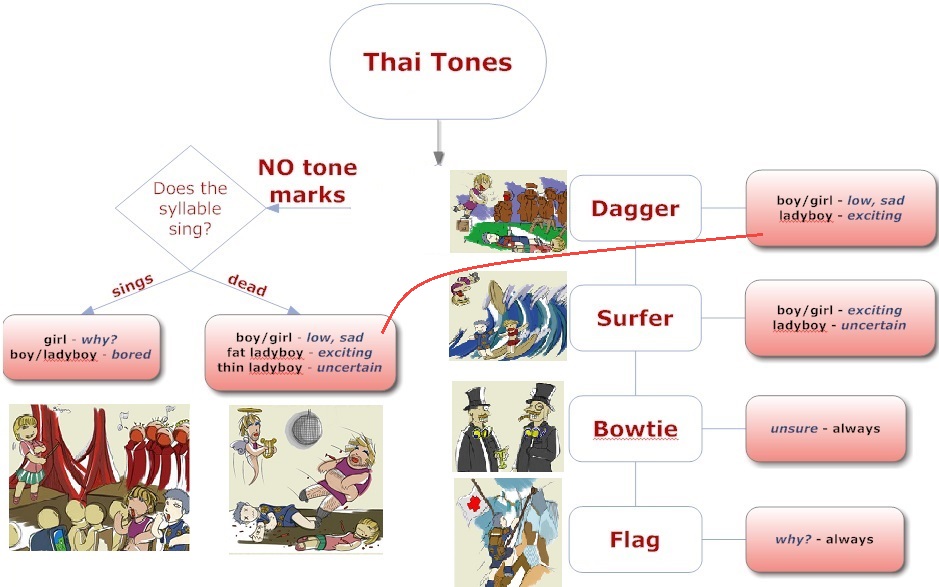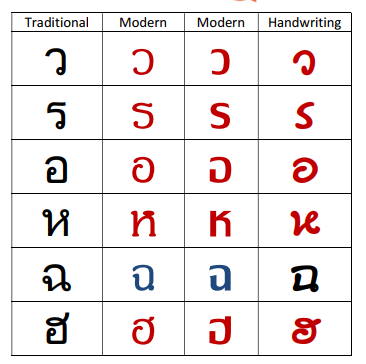So what about the tones?
It turns out that tones are almost a non-issue. Thais tend to speak in a monotone most of the time, no matter what the actual tone of the word is! (Read that again.) If you ask a Thai person (not a teacher) about tones, they will tell you that Thai is a monotone language. (Ask an English person if English is a tonal language… Heck, ask a Swedish person if they use tones also. Each person will insist that their language is spoken mostly in a monotone!)
Once you’ve understood what the tones should be (and if you master the tones ‘flow chart’ and make-subconscious the Four Questions (which you’ll get in the course), you can more or less ignore them. Tones DO need to be unmistakably expressed for certain words, usually where you pause for breath or where the word in the context of your conversation is ambiguous. You will eventually get to know the rhythm and musicality of Thai when you listen to full sentences spoken at natural speed.
It’s much easier and less confusing not to think of the letters as high/middle/low class – because of the way tones are usually described (“high”, “mid”, “low”, “rising”, “falling”). There is absolutely no one-to-one correspondence between the class and the tone. So a high letter will not give you a high tone, and so on.
It helps to convert the class definition that you learnt to the Rapid Method’s terminology (girls, boys and ladyboys), NOT the other way round. Please trust me on this. I spent five years not being able to speak Thai properly because I misunderstood how to correctly pronounce the tones in trying to follow the concept of high/falling/rising/etc. Very few Thai people could understand me, even though I was speaking relatively fluently. As far as they were concerned, I was speaking Whale!
This has been the experience of many people who can read and speak fluently but still think of tones in frequency terms (high/low/rising, etc.) Indeed, a few already-fluent people have attended my workshop primarily to deal with this issue.Although the frequency graph does sort of represent the sound of each tone, it is not only quite inaccurate, it is highly misleading and almost useless when it comes to real speech. When I listen to people speak and pay attention to how I feel when I speak, I notice that people nearly always drop their voice, regardless of the tone – unless they’re asking a question or using one of the polite endings like ครับ or คะ. The real indicator is the energy that’s exerted in making the sound, not so much the tone/frequency.
The Rapid Method’s Approach to Thai Tones
Here are the tones according to the Rapid Method:
The ‘uncertain’ or ‘surprised’ tone is spoken with a kind of a squeaky sound, however. It helps to physically scrunch up your face and eyes, like when you’re saying “what!?” in a surprised, sceptical, I-don’t-believe you tone. Yes, it’s kind of high-ish in sound; but it’s better to think ‘surprise’ because then the sound will come out right naturally. (The primary aim of this approach is so that you make the correct sounds naturally.)
The ‘question’ tone is more of a from-the-belly sound. It helps to physically place your hand on your belly as you say this sound (there’s lots of belly-holding and fist-shaking and face-scrunching in my system, which helps to produce the correct sounds naturally). Use these physical tricks. When you think in terms of the conventional, linguistic terminology (‘high’, ‘falling’, etc.), the very act of engaging your brain is like a spanner in the works: it stops the right sound coming out and contorts the sound.
To make a ‘question’ tone, I usually preface the word in question with “Are you …?” (“Are you fine?” = “Are you สอง?”) and the tone usually comes out right.
Same with the ‘surprise’ (aka ‘uncertain’) tone: start with “Is it really a …?” (“Is that really a rat!?” = “Is that really a รัก?” or “Is that really a ร้าน?) This is a difficult tone for us because it’s so similar to the ‘question’ tone and if you’re a bit lazy or thoughtless then you will usually make a ‘question’ tone. You really need to pause a fraction of a second and think “what!!??” (sometimes even a longish sound: “whaaaaat!!??”) while scrunching up your face.
As for the ‘exciting’ or ‘emphatic’ or ‘energetic’ tone, just make a fist and say “Yeah!!!” ข้าวแก้วetc. This is easy for us, but you do need to exert a lot of energy (and, yes, you can allow your voice to fall when you’ve expended the energy). However, it does feel a bit silly because you have to express genuine enthusiasm. In fact, if you’re not feeling silly then you’re probably not saying it right!
The ‘boring’ or ‘no tone’ is very level and deadpan: don’t speak with any inflection at all, and stretch out the sound a little while keeping it flat and monotonous. Your voice will fall naturally when you’re done. (Which is why the term “falling tone” is a complete misnomer.) The ‘sad’ tone is the same, but with your shoulders drooping a little as in (the second word): “Uh ohhh….” or “Oh dear…” (And, as to be expected, there probably won’t be any further falling off of your voice because you have already fallen as far as you can go. What you’ll get instead, is a kind of pinched sound to finish, like snuffing out a candle with your fingers.)
In the Rapid Method there are therefore the two question tones (‘belly question’ and ‘surprised’), the two deadpan monotones (‘no tone’ and ‘sad tone’) and the exciting or energetic tone.
If you’ve already internalized the conventional tone terminology then please use the following conversion table in all your thinking about tones in future:
| Rising tone |
belly question |
hand on belly – why? how? |
| High tone |
skeptical/surprise |
scrunch up face, what!? |
| Falling tone |
energetic/exciting |
make a fist – yeah! (exert a lot of energy) |
| Mid tone |
deadpan, robotic |
talk-like-a-robot – dead pan, flat, lingering, monotonous |
| Low tone |
sad, robotic |
drop your shoulders – oh dear…. (feel depressed) |
And then never even think in terms of rising/falling etc. again. When we speak Thai, to a Thai person, it’s probably the same experience that we native English speakers have when we listen to Singaporeans speak English. They speak English fluently and clearly, but always a bit off; and it takes extra concentration and several repeats before one can understand what they’re saying.
Now, to confuse the issue even further: most of the time, one doesn’t even change the intonation when speaking colloquially at natural speed anyway! Most words are run together as a stream of monotonous sound. The tricky bit is to know when it’s necessary to express the tone, and a good rule of thumb is to do so only when you pause for breath.
The Four Questions
The best way to figure out the tones is to work through the following mental process over and over again until it becomes second nature. You will ask yourself 2, 3 or 4 questions to figure out the tone:
QUESTION
1. IS THERE A TONE MARK?
YES
a. Surfer tone mark → 2. What is the sex?
boys & girls are exciting (yeah!),
ladyboys are uncertain (what!?).
b. Dagger tone mark → 2. What is the sex?
ladyboys are exciting/melodramatic (yeah!),
boys & girls are low/sad.
c. Bowtie tone mark → always uncertain (what!?)
d. Plus/Flag tone mark → always question (how?)
WHEN THERE IS NO TONE MARK:
2. What is the sound ending of the word?
Does it Sing? →
3. What is the sex?
girls are question tone (how?),
boys & ladyboys are no tone.
Is it Dead (or cut off in some way)? →
3. What is the sex? -> boys & girls are low/sad;
But for ladyboys,
4. look at the vowel →
short/thin vowel is uncertain tone (what!?),
long/fat vowel is exciting/melodramatic (yeah!)tone











 Click here to buy
Click here to buy
